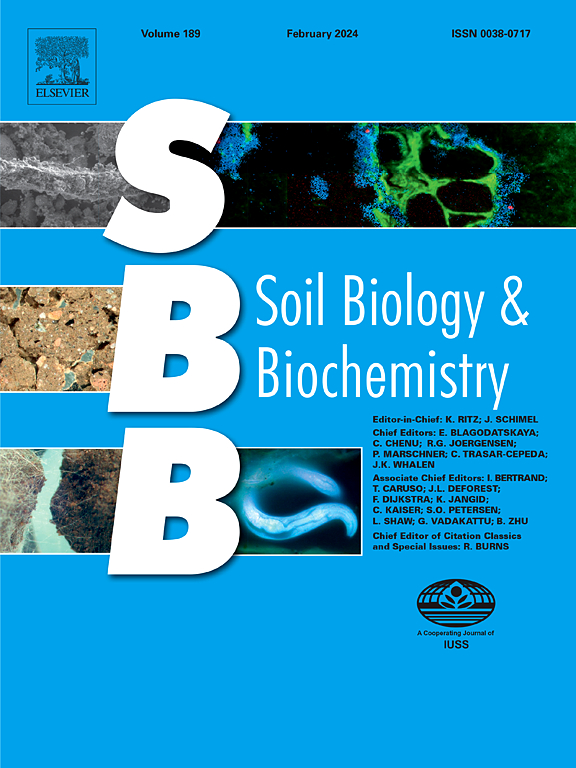Spatial dynamics of phosphorus mobilization by mycorrhiza
IF 9.8
1区 农林科学
Q1 SOIL SCIENCE
引用次数: 0
Abstract
Symbiosis with arbuscular mycorrhizal fungi (AMF) is a crucial strategy for plants to overcome phosphorus (P) deficiency, which is common in soils worldwide. This study explored the role of AMF in P mobilization using a maize-AMF symbiosis model under two levels of P availability in soil: 5.9 mg P kg−1 and 19 mg P kg−1. A newly developed three-compartment rhizobox was used to combine soil zymography with high-resolution diffusive gradients in thin-films (DGT) imaging, revealing P mobilization within the mycorrhizosphere through intensive soil-hyphae-root interactions. The AMF inoculation increased maize growth at both P levels, and was more pronounced at 19 mg P kg−1, including a 10 % increase in plant biomass and a 24 % increase in P content. AMF hyphae penetrated a nylon mesh barrier, facilitating P uptake from a compartment inaccessible to roots, thereby underscoring the critical role of AMF in raising plant P acquisition, particularly under P limitation. Soil zymography revealed increased acid phosphatase activity in the AMF-inoculated mycorrhizosphere compared to non-inoculated soil, coinciding with P-depletion microzones around the roots (as shown by DGT imaging). AMF inoculation expanded the hotspot area of acid phosphatase activity by 77 % compared to the control soil without AMF. This enzymatic boost of P mobilization and expansion in root system architecture increased root P uptake, alleviating plant P deficiency. In conclusion, the raise of the soil volume for P mobilization through AMF-plant symbiosis present potential strategy to increase P use efficiency in agricultural systems.
菌根对磷的空间动态动员
与丛枝菌根真菌(AMF)的共生是植物克服磷(P)缺乏的重要策略,这在世界范围内都很常见。本研究利用玉米-AMF共生模型,探讨了土壤磷有效性水平为5.9 mg P kg - 1和19 mg P kg - 1时,AMF在磷动员中的作用。利用新开发的三室根箱,将土壤酶谱法与高分辨率扩散梯度薄膜(DGT)成像相结合,揭示了通过土壤-菌丝-根相互作用在菌根圈内的磷动员。在两种磷水平下,接种AMF均能促进玉米生长,且在19 mg P kg - 1时更为显著,植株生物量增加10%,磷含量(g P kg - 1生物量)增加24%。AMF菌丝穿透尼龙网屏障,促进磷从根无法进入的隔室吸收,从而强调AMF在提高植物磷获取方面的关键作用,特别是在磷限制的情况下。土壤酶谱图显示,与未接种土壤相比,接种amf的菌根圈酸性磷酸酶活性增加,与根周围p耗损微区一致(如DGT成像所示)。与未接种AMF的对照土壤相比,接种AMF使酸性磷酸酶活性热点区扩大了77%。这种酶促进磷在根系结构中的动员和扩张,增加了根系对磷的吸收,减轻了植株的缺磷。综上所述,通过AMF-plant共生提高磷动员的土壤体积是提高农业系统磷利用效率的潜在策略。
本文章由计算机程序翻译,如有差异,请以英文原文为准。
求助全文
约1分钟内获得全文
求助全文
来源期刊

Soil Biology & Biochemistry
农林科学-土壤科学
CiteScore
16.90
自引率
9.30%
发文量
312
审稿时长
49 days
期刊介绍:
Soil Biology & Biochemistry publishes original research articles of international significance focusing on biological processes in soil and their applications to soil and environmental quality. Major topics include the ecology and biochemical processes of soil organisms, their effects on the environment, and interactions with plants. The journal also welcomes state-of-the-art reviews and discussions on contemporary research in soil biology and biochemistry.
 求助内容:
求助内容: 应助结果提醒方式:
应助结果提醒方式:


